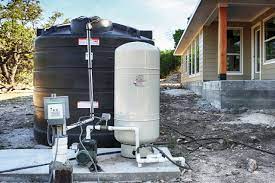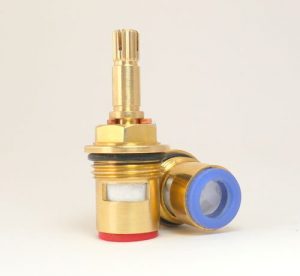You’ve probably seen a pressure tank attached to a water pump, but do you know what it does? It’s not just there for show. This vital component plays a key role in your water system’s operation.
In this article, we’ll delve into the mechanics of pressure tanks, explore different types available, and guide you on their installation and maintenance. You’ll also learn how to troubleshoot common issues.
Let’s get started!
Understanding the Role of a Pressure Tank in a Water Pump
You’ve got to understand that the role of a pressure tank on a water pump is vital. It’s responsible for storing pressurized water and maintaining consistent water pressure throughout your system. This crucial component ensures smooth operation of your pressure pump system, which in turn extends pump life.
The pressure tank works in tandem with the water pump to handle variations in demand. When you open a tap or start an appliance that requires water, the pre-pressurized air inside the tank pushes out the stored water into your distribution pipes. The drop in pressure within the tank triggers your pump to start replenishing its supply.
It’s imperative to monitor and maintain optimal pressure in the tank. Too high can lead to overworking your pump, while too low might result in inconsistent flow rates and potential damage due to frequent cycling on and off of your pump. To avoid these issues, some tanks have adjustable air bladders or diaphragms enabling customization of pressure levels.

The Mechanism Behind Pressure Tanks
In understanding the mechanism behind these devices, it’s key to know that they’re designed to hold and pressurize a certain amount of liquid. The pressure tank work starts when the water pump begins pumping water into it. As the volume of water inside increases, a rubber diaphragm becomes increasingly compressed. This creates a level of stored energy in the tank which is used to distribute pressurized water throughout your system.
To further understand this process:
At low volumes, the pump starts up frequently as it needs to replace the rapidly used up supply.
As more water gets pumped in, the rubber diaphragm becomes increasingly compressed creating a reserve pressure.
When you turn on a faucet or appliance that uses water, this built-up pressure pushes out the necessary volume.
It’s important you grasp these points because they help define how well your system works overall. An improperly functioning or incorrectly sized pressure tank can lead to frequent cycling of your pump and increased wear-and-tear. Understanding properly how these mechanisms behind pressure tanks function can save you time and money down the line.
Different Types of Pressure Tanks for Water Pumps
There’re various types of containers for hydraulic systems, each with its unique features and benefits. The three main types of pressure tanks used in water pumps are diaphragm tanks, bladder tanks, and air over water tanks. You’ll want to understand the differences between them to choose the right one for your specific needs.
Diaphragm Tanks:
These have a rubber diaphragm separating water from air chamber. They’re compact and efficient but can’t be repaired if the diaphragm fails. Perfect for smaller spaces where space is at a premium.
Bladder Tanks:
Similar to diaphragm tanks but have a durable bladder instead of a diaphragm. More reliable as they allow for easy replacement of the bladder. Ideal if you prefer longevity and ease of maintenance.
Air Over Water Tanks:
Traditional style tank with no separation between water and air. Less efficient due to potential for waterlogging. Suitable if you value simplicity and lower initial cost more than efficiency.
Each type has pros and cons, so consider your individual requirements carefully before selecting one of these different types of pressure tanks for your water pump system.
Installation and Maintenance of Pressure Tanks
Once you’ve chosen the right type for your needs, it’s time to focus on the proper installation and ongoing maintenance of pressure tanks. Correct installation will ensure that your pressure tank helps maintain a consistent flow rate and prolongs pump life.
Installation: The first step is placing your tank. It should ideally be located near the water source or water pumps, on a surface that can support its weight when full. Proper alignment and connectivity with pump lines are also crucial.
Maintenance: Regular checks are essential to detect leaks or corrosion early. Also, monitor the pressure gauge regularly; if it shows rapid changes, this could indicate problems.
Lifespan: With proper maintenance, pressure tanks can extend the lifespan of water pumps by reducing short cycling.
Remember, incorrect installation or lackadaisical maintenance can lead to ineffective operation or even damage to your pump system. By devoting time and attention to these steps, you’re not only ensuring an efficient and consistent flow rate but also potentially saving yourself from expensive repairs in the future.
The role of a well-maintained pressure tank in sustaining pump life cannot be overstated!
Troubleshooting Common Pressure Tank Issues
Let’s now delve into some common issues you might encounter with your system and how to troubleshoot them. Troubleshooting common pressure tank issues can range from pump cycling too frequently, a faulty pressure switch, or sudden pressure drops.
With the table below, you’ll grasp the cause of these problems and what steps to take:
Pump Cycling Too Often:
Check for water leaks in the system. If none are found, consider adjusting or replacing the pump switches.
Faulty Pressure Switch:
Inspect for damages on the pressure switch. It may need adjustment or replacement if it’s not triggering at the correct pressures.
Sudden Pressure Drops:
This could be due to a waterlogged tank. Drain your tank completely before refilling it. Regularly check your air charge as well.
Popular Questions
What Is the Average Lifespan of a Pressure Tank in a Water Pump?
You’re asking about the lifespan of a pressure tank. On average, you can expect it to last between 10-15 years. However, this varies based on usage and maintenance. Regular inspection will extend its longevity.
Can I Use a Pressure Tank With Any Type of Water Pump or Are They Specific to Certain Models?
You can use a pressure tank with various water pump models. However, it’s crucial to ensure compatibility between the two for optimal performance. Always check specifications and consult experts if you’re uncertain.
What Are Some Safety Precautions to Consider When Handling a Pressure Tank?
When handling a pressure tank, always ensure it’s depressurized before maintenance. Wear protective gear and avoid exposure to extreme temperatures. Don’t exceed the tank’s pressure limit and regularly inspect for leaks or damage.
How Does Weather or Environmental Factors Affect the Performance of a Pressure Tank?
Extreme weather conditions can affect your pressure tank’s performance. Cold can cause parts to contract, reducing efficiency, while heat may lead to expansion or corrosion. Always monitor and maintain it for optimal functioning in different environments.
Can a Pressure Tank Improve the Water Quality in My Home?
While a pressure tank doesn’t directly improve your home’s water quality, it does ensure consistent water flow. However, the water’s quality depends on your purification system rather than the pressure tank itself.
Conclusion
So, you’ve learned about pressure tanks on water pumps. They’re vital for maintaining constant water pressure and come in various types. Proper installation and maintenance are necessary for their efficient operation and longevity. Sometimes, pressure tanks can face issues. Now that you’re armed with this knowledge, managing your water system should be a whole lot easier!
Remember, understanding the technicalities is key to ensuring efficient operation and longevity of your equipment.





